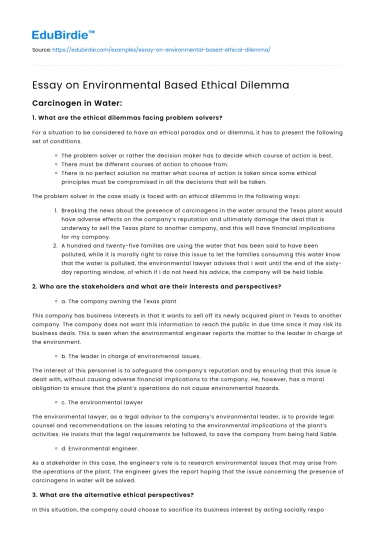Carcinogen in Water:
1. What are the ethical dilemmas facing problem solvers?
For a situation to be considered to have an ethical paradox and or dilemma, it has to present the following set of conditions.
- The problem solver or rather the decision maker has to decide which course of action is best.
- There must be different courses of action to choose from.
- There is no perfect solution no matter what course of action is taken since some ethical principles must be compromised in all the decisions that will be taken.
The problem solver in the case study is faced with an ethical dilemma in the following ways:
Save your time!
We can take care of your essay
- Proper editing and formatting
- Free revision, title page, and bibliography
- Flexible prices and money-back guarantee
- Breaking the news about the presence of carcinogens in the water around the Texas plant would have adverse effects on the company’s reputation and ultimately damage the deal that is underway to sell the Texas plant to another company, and this will have financial implications for my company.
- A hundred and twenty-five families are using the water that has been said to have been polluted, while it is morally right to raise this issue to let the families consuming this water know that the water is polluted, the environmental lawyer advises that I wait until the end of the sixty-day reporting window, of which if I do not heed his advice, the company will be held liable.
2. Who are the stakeholders and what are their interests and perspectives?
- a. The company owning the Texas plant
This company has business interests in that it wants to sell off its newly acquired plant in Texas to another company. The company does not want this information to reach the public in due time since it may risk its business deals. This is seen when the environmental engineer reports the matter to the leader in charge of the environment.
- b. The leader in charge of environmental issues.
The interest of this personnel is to safeguard the company’s reputation and by ensuring that this issue is dealt with, without causing adverse financial implications to the company. He, however, has a moral obligation to ensure that the plant’s operations do not cause environmental hazards.
- c. The environmental lawyer
The environmental lawyer, as a legal advisor to the company’s environmental leader, is to provide legal counsel and recommendations on the issues relating to the environmental implications of the plant’s activities. He insists that the legal requirements be followed, to save the company from being held liable.
- d. Environmental engineer.
As a stakeholder in this case, the engineer’s role is to research environmental issues that may arise from the operations of the plant. The engineer gives the report hoping that the issue concerning the presence of carcinogens in water will be solved.
3. What are the alternative ethical perspectives?
In this situation, the company could choose to sacrifice its business interest by acting socially responsible and accountable by issuing reports on the carcinogens in water.
In an ethical dilemma, no option is perfect and some principles or policies have to be compromised. In this situation, the financial gains of the company are not as important as human life and health.
4. What is your recommendation to solve the case?
As a problem solver in this situation, I would recommend that the company act ethically and morally by carrying out a test to tell where the contamination might have come from, and attempt to come up by coming up with ways to clear this mess. My decision is informed by the fact that an organization has a moral obligation to value humanity.






 Stuck on your essay?
Stuck on your essay?

